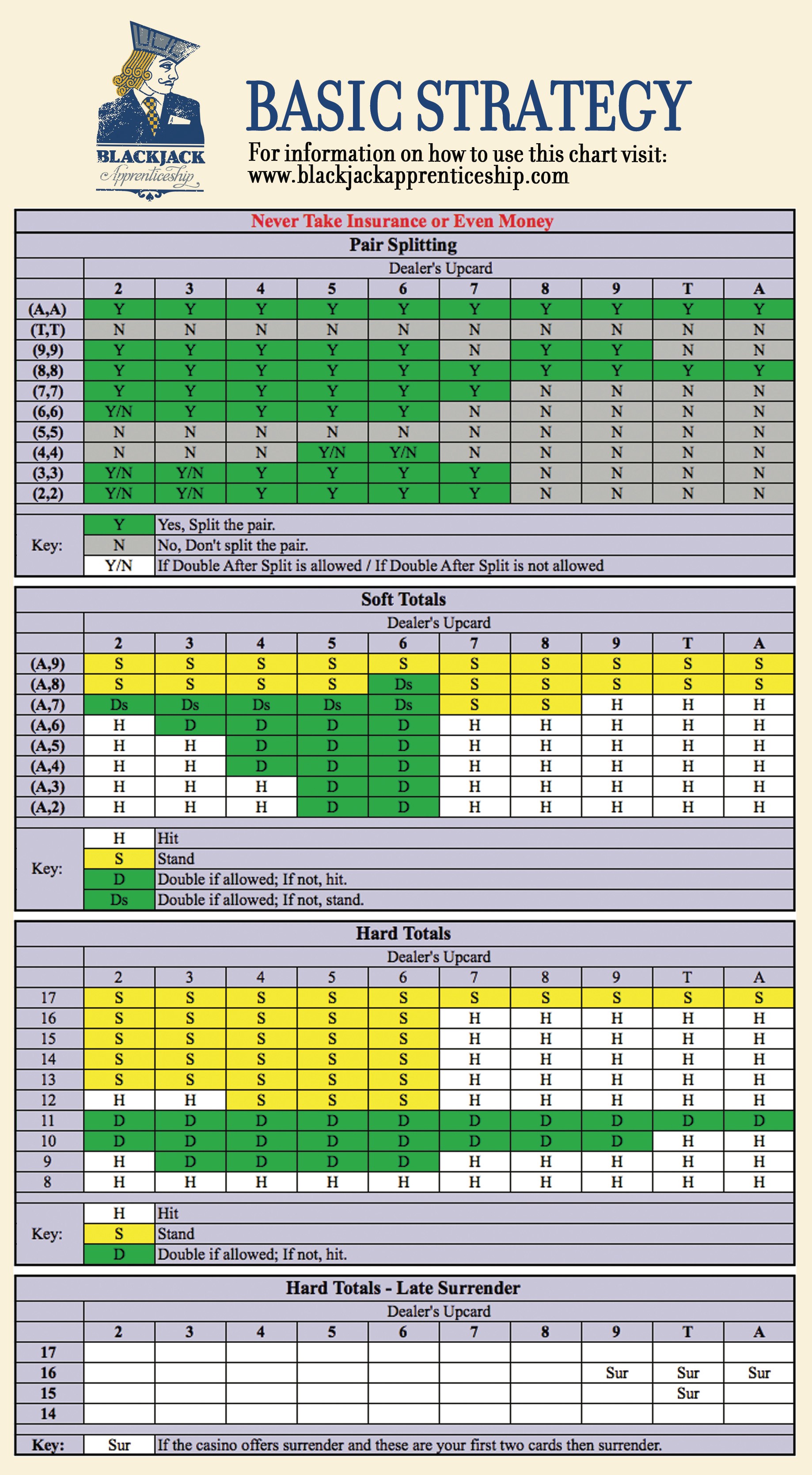
During high school, I often drove my roommates to Native American casinos in the Midwest for fun. We often played Blackjack because it?s easy to play and easy to buy in. Besides, the buffet at this one particular casino always fascinated us with their delicious all-you-can-eat oysters (I love eating raw oysters with Tabasco sauce ? it?s like eating a mermaid).
I was organizing my Google Drive today and found the old notes on how to win Blackjack I took years back. So I published it here.
First of all, what the hell is Blackjack?
You have 2 cards, and you can choose whether to hit, stand, split, double down, take insurance, or surrender depending on the situations.
The beautiful thing about Blackjack is you play against the house, not a machine, so you have better chance of winning.
SHORT VERSION
In short, the best ways to win Blackjack at casinos are:
- Stick to the basic guide, relentlessly. You can win with just using the basics, and you won?t lose more than it hurts. Search ?blackjack basic strategy chart? to learn it, or see below.
- Scale your bets up and down depending on whether you are winning or losing.
- Win moderately
- Don?t count card even if you know how to
- Tip the dealer
- Know when to leave
LONG VERSION
Most Casino often have typical Vegas Strip Rules.
Typical Vegas Strip Rules:
- Soft hand ? hand with an ace
- Shoe contains 6 decks (they mix 6 decks of cards together)
- Blackjack pays 3 to 2
- You can double down on any 2 cards
- You can double down after splitting (Except aces)
- When you split aces, you just can take one more card
- Re-spliting is allowed
- Some casino hits on soft 17
- SOMETIMES: Insurance pays 2 to 1
NEVER TAKE INSURANCE ? UNLESS YOU ARE COUNTING CARDS
JUST PLAY WITH BASIC STRATEGY FIRST
Basic Strategy: cuts the house?s edge and save money
- Without basic strategy ? 6 hours ? $25 a hand ? expect to lose $500
- With basic strategy ? 6 hours ? $25 a hand ? expect to lose $100
- Using basic strategy chart is LEGAL in Vegas and even encouraged
Optimal Betting:
- Bank Roll: HOW MUCH YOU ARE WILLING TO LOSE WITHOUT GOING CRAZY
- Determine your betting unit: should be at most 1/1000 of your bankroll
- For each session your cash on hand should be at least thirty-two betting units (Example: if betting $10 a hand, then you should bring $320 in cash)
- Start with a small betting unit
- Raise or lower your betting unit as your bankroll changes
BY CONSTANTLY ADJUSTING YOUR BETTING UNIT, YOU WILL NEVER GO BROKE, AND YOUR BANKROLL WILL INCREASE FASTER IN THE LONG RUN
- Maximum bet: should be at least 4x your betting unit
- Never bet more than 1/4 of the money on you on one round, because you want to have enough money to split and double down
IF YOU ARE THE ONLY PLAYER AT THE TABLE (OR JUST CAN ONLY PLAY ONE HAND), THEN BET 25% MORE ON ONE HAND
Here is a basic strategy guide that you can rely on:

COUNTING CARDS (NOT RECOMMENDED)
It?s not recommended for novice nor professional players to count cards at casinos. You will get into lots of trouble for doing so.
Counting cards is a system that give you knowing of probability whether or not the next card is a high card or a low card. It?s illegal in all casinos.
In the Midwest of United States, most casinos have their own enforcement that the police cannot touch, because it?s property of Native Americans. So I don?t recommend counting cards at all. This is just probability learning.
There are many card counting system. Personally, I like the Hi-Lo system. It?s simple and fun to learn.
First, The Fundamentals
Betting In Multiples Of Betting Unit According To The Count:
- Keep the running count ? You can round the running count (Example: from 19 to 20)
- Approximate the number of decks remaining (watch the decks in a card tray -> determine the decks in the shoe) ? You can round the decks remaining ( Example: from 4 up to 5)
- Divide the running count by the number of decks remaining -> the True Count
- Subtract 1 from the True Count to determine how many units to bet
- Multiply the Number of Units to bet by the Betting Unit
- Play 2 hands and bet that amount per hand
- If the count result is less than 0, bet as little as you can without drawing too much attention to your bet. Sit out if you can get away with it.
Counting Cards: Hi-lo system (the one I like most)
- Low cards: 2,3,4,5,6 are good when removed ? positive count (+1)
- High cards: 10,J,Q,K,A are bad when removed ? negative count (-1)
- Middle cards: 7,8,9 are neutral so they are worth 0
It?s better when counting at the beginning of the shoe.
Practice Drills for Counting:
- Always carry a deck with you
- Run through the entire deck in your hand while keeping the count, it should come out to zero
- Deal cards on the table while keeping the count
- Have a partner deal to you while trying to play and count
- Try to play and say and count while the dealer says the card face values
- COUNT DOWN AND PLAY 3 SHOES IN A ROW WHILE ONLY MAKING 3 COUNTING ERRORS OR LESS WHILE YOUR PARTNER TRIES TO DISTRACT YOU
Team Play Counting
- The Back-SpotterThe Back-Spotter can count cards without even being seated at the blackjack table. When the count gets hot ? meaning the house is at a statistical disadvantage ? this player will signal for the team?s bettors to swoop in.
- The Spotter Acts like a high roller or drunk, making large bets based on the signal from the SpotterThe Spotter counts cards while playing at the table. Casinos screen for counters by watching for dramatic rises or drops in bets ? a sure sign that a deck has gone hot or cold. A Spotter avoids detection by resolutely sticking to the minimum bet on each hand. When it?s time to start betting big to take advantage of a favorable deck, he tips off his teammates(True Count is about 3)
- The GorillaThe Gorilla doesn?t count at all: He just bets big, all the time. Typically, he adopts the pose of a drunken millionaire who has green to burn. The Spotters ensure the Gorilla?s luck by steering him to tables where he?s got greater than even odds of winning against the house.
- The Big PlayerThe Big Player appears to be a type well known to the casinos: the high-rolling recreational gambler who?s content to slowly bleed his money away through hours of competent play. In reality, he?s a Spotter with a Gorilla?s bankroll. He?s not only counting cards, he?s tracking the shuffle for the high cards that rob the house of its advantage. A BP always plays a good deck, so he never has to lower his bets by much.
CARD COUNTERS ARE SPOTTED BY THEIR BETTING PATTERNS
Pit boss and casino watchers are professionally trained to spot cheaters, and they take any means necessary to ensure that the player knows they are serious.
Spotting A Card Counter:
- Player conspicuously bets based on card count
Camouflage = GOOD ACTING & BAD PLAY (don?t even try)
- Acting uninterested in other players? cards
- Talking to the other players at the table
- Pretending to raise the winning streak when the count is high
- Pretending to be drunk
- Pretending to be a high roller
- Convince the casino you are a juicy customer with Bad Play
- Making basic strategy mistake but don?t make too costly mistake
- Raising your bet when the count goes down
- Raising or lower your bet when the count is even
Last But Not Least, BE A HEAT DETECTOR:
Always pay attention to the surroundings. Know when to take your win and leave, if you are (even if you are not) counting cards:
- The pit boss looks at you and begins scribbling notes
- The pit boss starts talking to you
- The pit boss intructs the dealer to shuffle up -> Leave quietly
- The pit boss glares at you and then gets on the phone -> Leave
- The pit boss asks you to stop playing blackjack or to leave -> Don?t argue, just leave
I hope this guide will help you have fun and win a little bit at casino for fun. Nothing more, nothing less.


